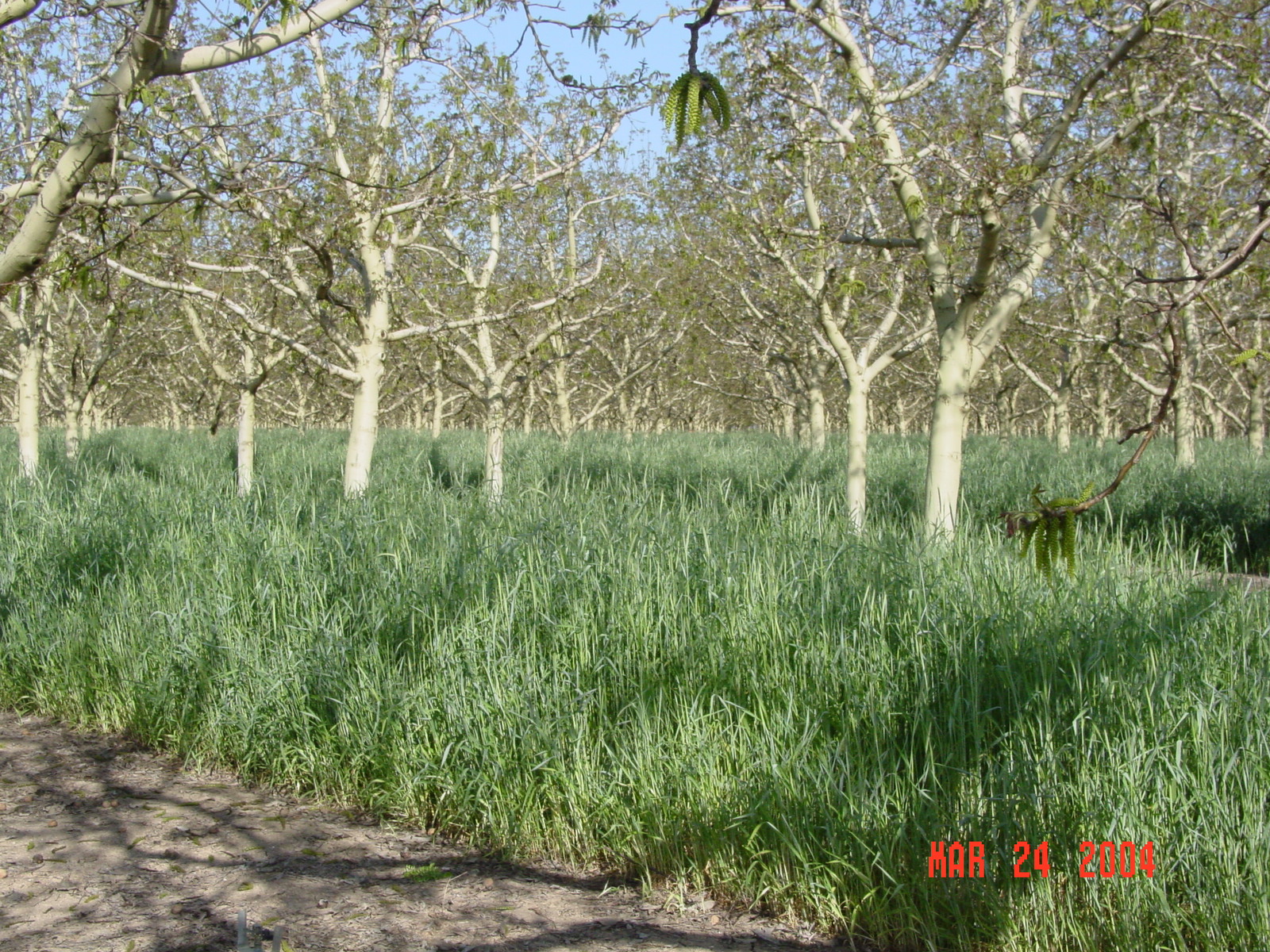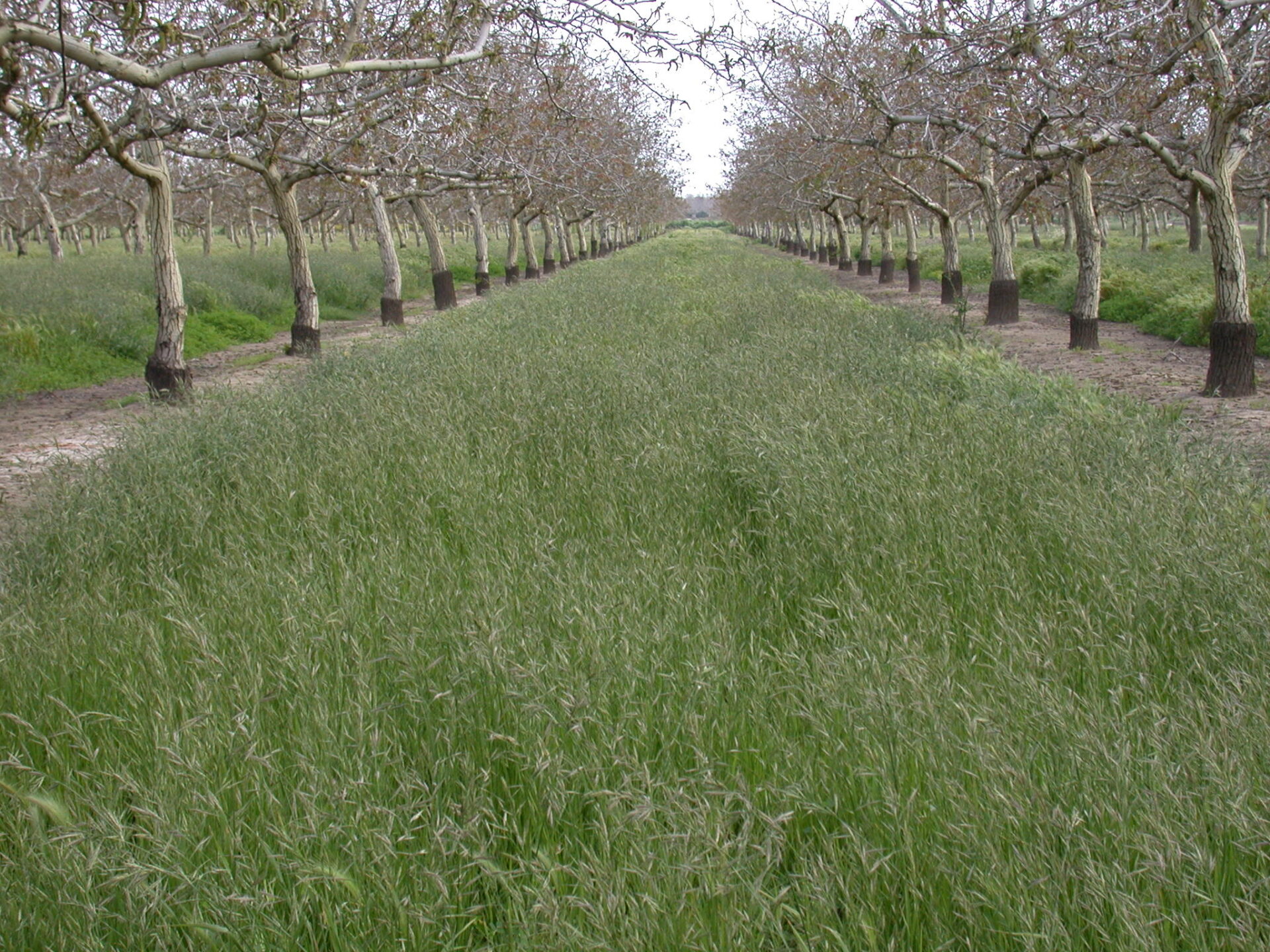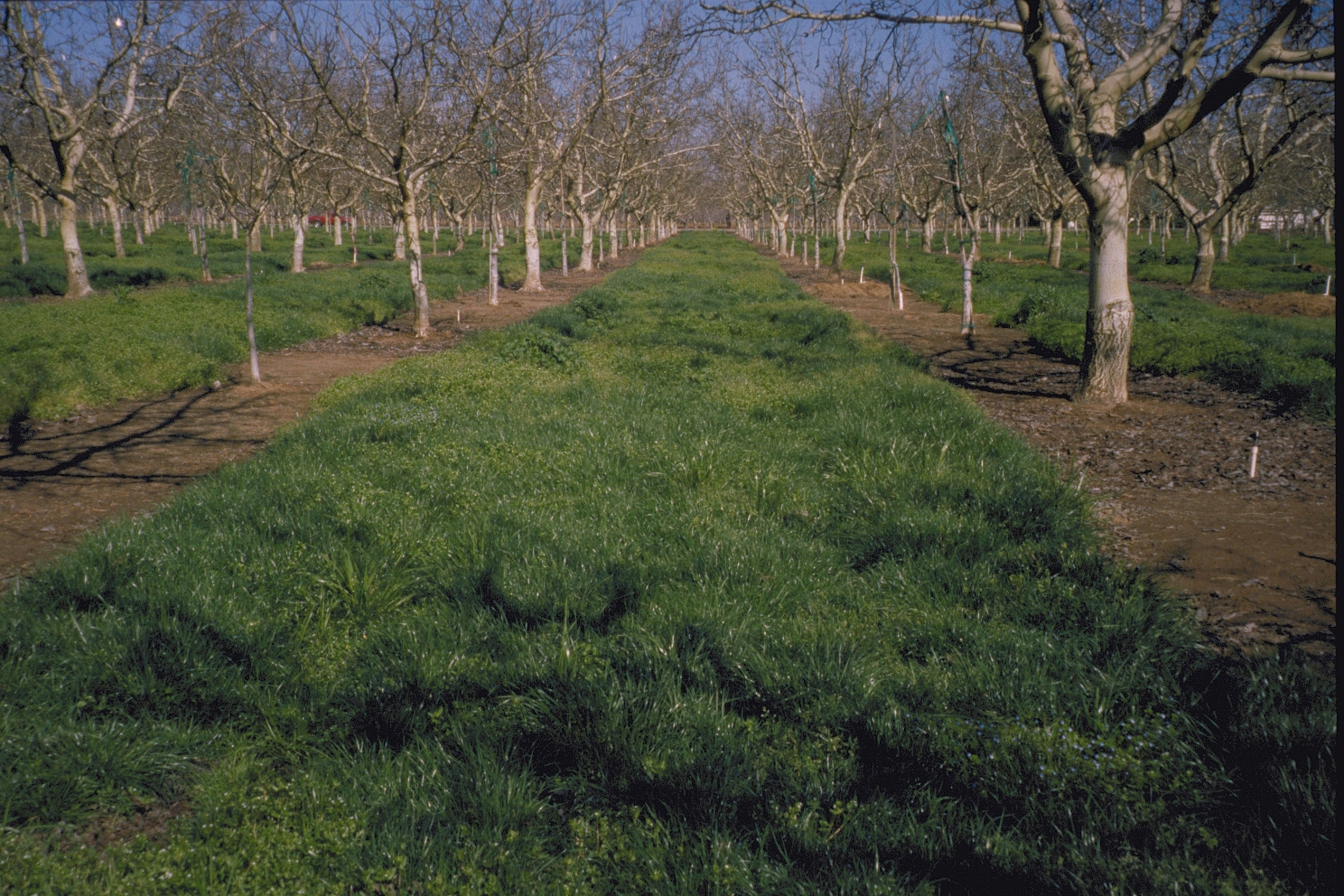
A steady rise in intentionally planted cover crops in walnut orchards has been noted by UCCE Advisor Emeritus Joe Grant, who now serves as production research director for the California Walnut Board.
“There has been a steady increase each year of growers who start, intentionally, to have cover crops in their orchards.” Grant said. “There has been more promotion of this practice recently.”
Just allowing a crop of winter weeds to germinate and grow in the orchard won’t provide equal benefits to a chosen and planted cover crop. Large weeds can become problematic by spreading into tree rows.
Young walnut orchards can benefit from a planted cover crop due to its value as a green manure. A big driver of increased cover crop use, Grant said, is the goal of improving water penetration in the orchard. Cover crop decomposition adds organic matter to the soil, aiding water infiltration and water holding capacity. Cover crops can help prevent soil crusting by protecting the soil surface from the impact of sprinkler droplets and help improve traction and reduce compaction from machinery used in the orchard, especially in the winter.
Depending on the species in the cover crop mix, the plants can extract nitrogen not taken up by the tree and convert it to more stable organic forms. Cover crops can take up excess water from winter rains. Cover crops can also reduce erosion on slopes and areas subject to flooding and remove excess soil from winter rains in the spring when it can increase the risk of soilborne disease problems.
Cover crops can help with dust control, improving soil structure and protecting soil from wind.
Even with all the promoted benefits of a cover crop in a walnut orchard, Grant said that establishing fall-planted cover crops can be challenging and requires pre-planning.
“These cover crops need to be planted right after harvest, and the later varieties of walnuts like Chandler bump right up against cover crop planting time,” Grant said.

In mature orchards, lack of sunlight and leaf litter on the orchard floor can interfere with stand establishment. If the orchard floor is dry at planting and no rain is in the forecast, irrigation may be required for germination.
Water use by a cover crop will increase the total orchard water requirement. In the spring, cover crops deplete stored soil moisture from winter rains. A UCCE cover crop guide for walnuts notes that a typical 5,000-pound-per-acre (dry weight) cool-season green manure cover crop can consume as much as about 180,000 gallons, or 6.5 acre-inches, of water.
There is also a risk of spring frost damage to young trees when a cover crop is grown in the orchard. A bare orchard floor absorbs heat during the day and releases it at night, but a cover crop reduces this heat absorption. This risk can be mitigated by mowing the cover crop well in advance if a severe frost event is forecast.
Cover crops can also interfere with spring orchard sanitation and orchard pruning operations. Destroying mummy nuts on the orchard floor to control navel orangeworm may require mowing the cover crop and decreasing its ultimate biomass production.
In orchards with pocket gophers or voles, cover crops may aid in increasing their populations as gopher mounds can become hidden from site and vole runways can be sheltered.
Population dynamics of three nematode species that attack walnut, ring nematode, root knot nematode and root lesion nematode may be affected by planting cover crops. Research shows that nematodes are less active in cooler months, and mowing or disking a cover crop by mid-May could limit their potential for harm. Sampling soil for nematodes pre-plant can help with cover crop planting decisions.
Choosing a System
Three cover crop systems have been used successfully in walnut orchards. These systems all have potential benefits as well as drawbacks to consider when choosing cover crops to meet needs in different orchard situations.
The first is a winter green manure crop that usually consists of large-seeded cereal grains and one or more nitrogen-fixing legumes. This crop is newly seeded each year in the fall and mowed or disked in the spring. This system fits especially well in cultivated orchards as the fertility benefits are maximized with the crop residue incorporated in the soil. If there is adequate soil moisture in the fall, this system may not need additional irrigation for germination and growth.
Annual reseeding legumes, including common vetch, subterranean or crimson clover, bur medic or grasses (Blando brome) are planted in the fall and managed during spring and early summer for seed production to allow for reestablishment in the fall. This system can only be maintained in non-cultivated orchards. It may also need irrigation if fall and winter rains have not provided adequate moisture for good growth.
Perennial sods include grasses such as perennial ryegrass and various fescues and/or legumes. The species are planted in fall through spring and mowed to maintain a year-round orchard floor covering. Irrigation beyond what is needed by trees is needed to maintain good growth.
Grant said there is an additional spring-planted cover crop strategy that includes warm-season species, such as sudan and cowpea. These species are helpful in increasing soil organic matter and improving tilth and water holding capacity, particularly in sandy soils. Their main drawback is increased water use and potential to contribute to nematode populations.
Planting, Management Strategies
To maximize their benefit, cover crops should be planted in as wide a strip as possible.
To maximize efficiency, the width of the planted strips usually matched the width of cultivating, seeding and mowing equipment advised. Planting with a no-till seed drill helps minimize disturbance on the orchard floor. Drilling seed also involves less ground preparation that broadcast seeding and is a more precise operation.
Removal of green manure cover crops is done by disking in cultivated orchards. A heavy crop can be mowed prior to disking. Flail or rotary mowers are used in non-cultivated orchards. Annual reseeding cover crops should be mowed to a half inch to one inch in height to reduce competition from winter weeds. The grasses in this type of cover crop do not tolerate the short mowing as well as the clovers. A second and final mowing is done in early to mid-June once seed has fully matured to ensure satisfactory reestablishment of the cover crop the following winter. A successful stand can be reestablished if half or more of plants in the cover crop produce mature seed before they are removed by mowing or disking. Mowing more frequently delays flowering and seed development by most annual reseeding species. Mowed residue left on the soil surface helps suppress summer weeds and will decompose by harvest.
















